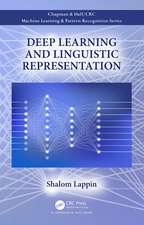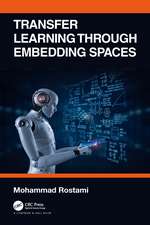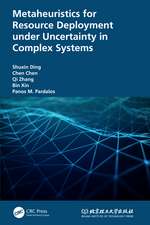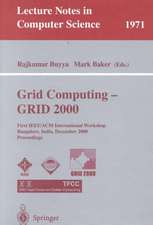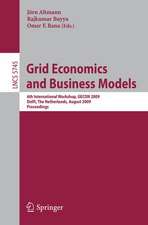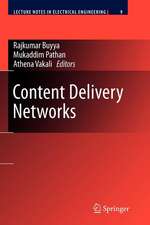Machine Learning for Cloud Management
Autor Jitendra Kumar, Ashutosh Kumar Singh, Anand Mohan, Rajkumar Buyyaen Limba Engleză Paperback – 26 noi 2021
Machine Learning for Cloud Management explores cloud resource management through predictive modelling and virtual machine placement. The predictive approaches are developed using regression-based time series analysis and neural network models. The neural network-based models are primarily trained using evolutionary algorithms, and efficient virtual machine placement schemes are developed using multi-objective genetic algorithms.
Key Features:
- The first book to set out a range of machine learning methods for efficient resource management in a large distributed network of clouds.
- Predictive analytics is an integral part of efficient cloud resource management, and this book gives a future research direction to researchers in this domain.
- It is written by leading international researchers.
| Toate formatele și edițiile | Preț | Express |
|---|---|---|
| Paperback (1) | 449.01 lei 6-8 săpt. | |
| CRC Press – 26 noi 2021 | 449.01 lei 6-8 săpt. | |
| Hardback (1) | 1047.43 lei 6-8 săpt. | |
| CRC Press – 26 noi 2021 | 1047.43 lei 6-8 săpt. |
Preț: 449.01 lei
Preț vechi: 561.27 lei
-20% Nou
Puncte Express: 674
Preț estimativ în valută:
85.93€ • 89.17$ • 71.82£
85.93€ • 89.17$ • 71.82£
Carte tipărită la comandă
Livrare economică 17-31 martie
Preluare comenzi: 021 569.72.76
Specificații
ISBN-13: 9780367622565
ISBN-10: 0367622564
Pagini: 198
Ilustrații: 254
Dimensiuni: 178 x 254 x 11 mm
Greutate: 0.5 kg
Ediția:1
Editura: CRC Press
Colecția Chapman and Hall/CRC
ISBN-10: 0367622564
Pagini: 198
Ilustrații: 254
Dimensiuni: 178 x 254 x 11 mm
Greutate: 0.5 kg
Ediția:1
Editura: CRC Press
Colecția Chapman and Hall/CRC
Public țintă
Academic, Postgraduate, Professional, and Professional Practice & DevelopmentCuprins
List of Figures
List of Tables
Preface
Author Bios
Abbreviations
Introduction
1.1 CLOUD COMPUTING
1.2 CLOUD MANAGEMENT
1.2.1 Workload Forecasting
1.2.2 Load Balancing
1.3 MACHINE LEARNING
1.3.1 Artificial Neural Network
1.3.2 Metaheuristic Optimization Algorithms
1.3.3 Time Series Analysis
1.4 WORKLOAD TRACES
1.5 EXPERIMENTAL SETUP & EVALUATION METRICS
1.6 STATISTICAL TESTS
1.6.1 Wilcoxon Signed-Rank Test
1.6.2 Friedman Test
1.6.3 Finner Test
Time Series Models
2.1 AUTOREGRESSION
2.2 MOVING AVERAGE
2.3 AUTOREGRESSIVE MOVING AVERAGE
2.4 AUTOREGRESSIVE INTEGRATED MOVING AVERAGE
2.5 EXPONENTIAL SMOOTHING
2.6 EXPERIMENTAL ANALYSIS
2.6.1 Forecast Evaluation
2.6.2 Statistical Analysis
Error Preventive Time Series Models
3.1 ERROR PREVENTION SCHEME
3.2 PREDICTIONS IN ERROR RANGE
3.3 MAGNITUDE OF PREDICTIONS
3.4 ERROR PREVENTIVE TIME SERIES MODELS
3.4.1 Error Preventive Autoregressive Moving Average
3.4.2 Error Preventive Auto Regressive Integrated Moving Average
3.4.3 Error Preventive Exponential Smoothing
3.5 PERFORMANCE EVALUATION
3.5.1 Comparative Analysis
3.5.2 Statistical Analysis
Metaheuristic Optimization Algorithms
4.1 SWARM INTELLIGENCE ALGORITHMS IN PREDICTIVE MODEL
4.1.1 Particle Swarm Optimization
4.1.2 Firefly Search Algorithm
4.2 EVOLUTIONARY ALGORITHMS IN PREDICTIVE MODEL
4.2.1 Genetic Algorithm
4.2.2 Differential Evolution
4.3 NATURE INSPIRED ALGORITHMS IN PREDICTIVE MODEL
4.3.1 Harmony Search
4.3.2 Teaching Learning Based Optimization
4.4 PHYSICS INSPIRED ALGORITHMS IN PREDICTIVE MODEL
4.4.1 Gravitational Search Algorithm
4.4.2 Blackhole Algorithm
4.5 STATISTICAL PERFORMANCE ASSESSMENT
Evolutionary Neural Networks
5.1 NEURAL NETWORK PREDICTION FRAMEWORK DESIGN
5.2 NETWORK LEARNING
5.3 RECOMBINATION OPERATOR STRATEGY LEARNING
5.3.1 Mutation Operator
5.3.1.1 DE/current to best/1
5.3.1.2 DE/best/1
5.3.1.3 DE/rand/1
5.3.2 Crossover Operator
5.3.2.1 Ring Crossover
5.3.2.2 Heuristic Crossover
5.3.2.3 Uniform Crossover
5.3.3 Operator Learning Process
5.4 ALGORITHMS AND ANALYSIS
5.5 FORECAST ASSESSMENT
5.5.1 Short Term Forecast
5.5.2 Long Term Forecast
5.6 COMPARATIVE ANALYSIS
Self Directed Learning
6.1 NON-DIRECTED LEARNING BASED FRAMEWORK
6.1.1 Non-Directed Learning
6.2 SELF-DIRECTED LEARNING BASED FRAMEWORK
6.2.1 Self Directed Learning
6.2.2 Cluster Based Learning
6.2.3 Complexity analysis
6.3 FORECAST ASSESSMENT
6.3.1 Short Term Forecast
6.3.1.1 Web Server Workloads
6.3.1.2 Cloud Workloads
6.4 LONG TERM FORECAST
6.4.0.1 Web Server Workloads
6.4.0.2 Cloud Workloads
6.5 COMPARATIVE & STATISTICAL ANALYSIS
Ensemble Learning
7.1 EXTREME LEARNING MACHINE
7.2 WORKLOAD DECOMPOSITION PREDICTIVE FRAMEWORK
7.2.1 Framework Design
7.3 ELM ENSEMBLE PREDICTIVE FRAMEWORK
7.3.1 Ensemble Learning
7.3.2 Expert Architecture Learning
7.3.3 Expert Weight Allocation
7.4 SHORT TERM FORECAST EVALUATION
7.5 LONG TERM FORECAST EVALUATION
7.6 COMPARATIVE ANALYSIS
Load Balancing
8.1 MULTI-OBJECTIVE OPTIMIZATION
8.2 RESOURCE EFFICIENT LOAD BALANCING FRAMEWORK
8.3 SECURE AND ENERGY AWARE LOAD BALANCING FRAMEWORK
8.3.1 Side Channel Attacks
8.3.2 Ternary Objective VM Placement
8.4 SIMULATION SETUP
8.5 HOMOGENEOUS VM PLACEMENT ANALYSIS
8.6 HETEROGENEOUS VM PLACEMENT ANALYSIS
Bibliography
Index
List of Tables
Preface
Author Bios
Abbreviations
Introduction
1.1 CLOUD COMPUTING
1.2 CLOUD MANAGEMENT
1.2.1 Workload Forecasting
1.2.2 Load Balancing
1.3 MACHINE LEARNING
1.3.1 Artificial Neural Network
1.3.2 Metaheuristic Optimization Algorithms
1.3.3 Time Series Analysis
1.4 WORKLOAD TRACES
1.5 EXPERIMENTAL SETUP & EVALUATION METRICS
1.6 STATISTICAL TESTS
1.6.1 Wilcoxon Signed-Rank Test
1.6.2 Friedman Test
1.6.3 Finner Test
Time Series Models
2.1 AUTOREGRESSION
2.2 MOVING AVERAGE
2.3 AUTOREGRESSIVE MOVING AVERAGE
2.4 AUTOREGRESSIVE INTEGRATED MOVING AVERAGE
2.5 EXPONENTIAL SMOOTHING
2.6 EXPERIMENTAL ANALYSIS
2.6.1 Forecast Evaluation
2.6.2 Statistical Analysis
Error Preventive Time Series Models
3.1 ERROR PREVENTION SCHEME
3.2 PREDICTIONS IN ERROR RANGE
3.3 MAGNITUDE OF PREDICTIONS
3.4 ERROR PREVENTIVE TIME SERIES MODELS
3.4.1 Error Preventive Autoregressive Moving Average
3.4.2 Error Preventive Auto Regressive Integrated Moving Average
3.4.3 Error Preventive Exponential Smoothing
3.5 PERFORMANCE EVALUATION
3.5.1 Comparative Analysis
3.5.2 Statistical Analysis
Metaheuristic Optimization Algorithms
4.1 SWARM INTELLIGENCE ALGORITHMS IN PREDICTIVE MODEL
4.1.1 Particle Swarm Optimization
4.1.2 Firefly Search Algorithm
4.2 EVOLUTIONARY ALGORITHMS IN PREDICTIVE MODEL
4.2.1 Genetic Algorithm
4.2.2 Differential Evolution
4.3 NATURE INSPIRED ALGORITHMS IN PREDICTIVE MODEL
4.3.1 Harmony Search
4.3.2 Teaching Learning Based Optimization
4.4 PHYSICS INSPIRED ALGORITHMS IN PREDICTIVE MODEL
4.4.1 Gravitational Search Algorithm
4.4.2 Blackhole Algorithm
4.5 STATISTICAL PERFORMANCE ASSESSMENT
Evolutionary Neural Networks
5.1 NEURAL NETWORK PREDICTION FRAMEWORK DESIGN
5.2 NETWORK LEARNING
5.3 RECOMBINATION OPERATOR STRATEGY LEARNING
5.3.1 Mutation Operator
5.3.1.1 DE/current to best/1
5.3.1.2 DE/best/1
5.3.1.3 DE/rand/1
5.3.2 Crossover Operator
5.3.2.1 Ring Crossover
5.3.2.2 Heuristic Crossover
5.3.2.3 Uniform Crossover
5.3.3 Operator Learning Process
5.4 ALGORITHMS AND ANALYSIS
5.5 FORECAST ASSESSMENT
5.5.1 Short Term Forecast
5.5.2 Long Term Forecast
5.6 COMPARATIVE ANALYSIS
Self Directed Learning
6.1 NON-DIRECTED LEARNING BASED FRAMEWORK
6.1.1 Non-Directed Learning
6.2 SELF-DIRECTED LEARNING BASED FRAMEWORK
6.2.1 Self Directed Learning
6.2.2 Cluster Based Learning
6.2.3 Complexity analysis
6.3 FORECAST ASSESSMENT
6.3.1 Short Term Forecast
6.3.1.1 Web Server Workloads
6.3.1.2 Cloud Workloads
6.4 LONG TERM FORECAST
6.4.0.1 Web Server Workloads
6.4.0.2 Cloud Workloads
6.5 COMPARATIVE & STATISTICAL ANALYSIS
Ensemble Learning
7.1 EXTREME LEARNING MACHINE
7.2 WORKLOAD DECOMPOSITION PREDICTIVE FRAMEWORK
7.2.1 Framework Design
7.3 ELM ENSEMBLE PREDICTIVE FRAMEWORK
7.3.1 Ensemble Learning
7.3.2 Expert Architecture Learning
7.3.3 Expert Weight Allocation
7.4 SHORT TERM FORECAST EVALUATION
7.5 LONG TERM FORECAST EVALUATION
7.6 COMPARATIVE ANALYSIS
Load Balancing
8.1 MULTI-OBJECTIVE OPTIMIZATION
8.2 RESOURCE EFFICIENT LOAD BALANCING FRAMEWORK
8.3 SECURE AND ENERGY AWARE LOAD BALANCING FRAMEWORK
8.3.1 Side Channel Attacks
8.3.2 Ternary Objective VM Placement
8.4 SIMULATION SETUP
8.5 HOMOGENEOUS VM PLACEMENT ANALYSIS
8.6 HETEROGENEOUS VM PLACEMENT ANALYSIS
Bibliography
Index
Notă biografică
Jitendra Kumar is an assistant professor in machine learning at the National Institute of Technology Tiruchirappalli, Tamilnadu, India. He obtained his doctorate in 2019 from the National Institute of Technology Kurukshetra, Haryana, India. He is also a recipient of the Director’s medal for the first rank in the University examination at Dayalbagh Educational Institute, Agra, Uttar Pradesh in 2011. He has experience of three years in academia. He has published several research papers in international journals and conferences of high repute, including IEEE Transactions on Parallel and Distributed Systems, Information Sciences, Future Generation Computer Systems, Neurocomputing, Soft Computing, Cluster Computing, IEEE-FUZZ, etc. He has also obtained the best paper awards in two international conferences. His research interests are machine learning, cloud computing, healthcare, parallel algorithms, and optimization. He is also a review board member of several journals, including IEEE Transactions on Computers, IEEE Transactions on Parallel and Distributed Systems, IEEE Access, Journal and Parallel Distributed Computing, and more.
Ashutosh Kumar Singh is an esteemed researcher and academician in the domain of Electrical and Computer engineering. Currently, he is working as a Professor; Department of Computer Applications; National Institute of Technology; Kurukshetra, India. He has more than 20 years research, teaching and administrative experience in various University systems of the India, UK, Australia and Malaysia. Dr. Singh obtained his Ph. D. degree in Electronics Engineering from Indian Institute of Technology-BHU, India; Post Doc from Department of Computer Science, University of Bristol, United Kingdom and Charted Engineer from United Kingdom. He is the recipient of Japan Society for the Promotion of Science (JSPS) fellowship for visit in University of Tokyo and other universities of Japan. His research area includes Verification, Synthesis, Design and Testing of Digital Circuits, Predictive Data Analytics, Data Security in Cloud, Web Technology. He has more than 250 publications till now which includes peer reviewed journals, books, conferences, book chapters and news magazines in these areas. He has co-authored eight books including ‘‘Web Spam Detection Application using Neural Network’’, ‘‘Digital Systems Fundamentals’’ and ‘‘Computer System Organization & Architecture’’. Prof. Singh has worked as principal investigator/investigator for six sponsored research projects and was a key member on a project from EPSRC (United Kingdom) entitled ’’Logic Verification and Synthesis in New Framework’’.
Anand Mohan has nearly 44 years of experience in teaching and research and the administration and management of higher educational institutions. He is currently an institute professor in the Department of Electronics Engineering, Indian institute of Technology (BHU), Varanasi, India. Besides his present academic assignment, Prof. Mohan is a Member of the Executive Council of Banaras Hindu University and Vice-Chairman of the Board of Governors of Indian Institute of Technology (BHU), Varanasi, India. Prof. Mohan served as Director (June 2011--June 2016) of the National Institute of Technology (NIT), Kurukshetra, Haryana, India and was also Mentor Director of the National Institute of Technology, Srinagar, Uttarakhand, India. For his outstanding contributions in the field of Electronics Engineering, Prof. Mohan was conferred the ’’Lifetime Achievement Award’’ (2016) by Kamla Nehru Institute of Technology, Sultanpur, India.
Rajkumar Buyya is a Redmond Barry Distinguished Professor and Director of the Cloud Computing and Distributed Systems (CLOUDS) Laboratory at the University of Melbourne, Australia. He is also serving as the founding CEO of Manjrasoft Pty Ltd., a spin-off company of the University, commercialising its innovations in Cloud Computing. He served as a Future Fellow of the Australian Research Council during 2012-2016. He serving/served as Honorary/Visiting Professor for several elite Universities including Imperial College London (UK), University of Birmingham (UK), University of Hyderabad (India), and Tsinghua University (China). He received B.E and M.E in Computer Science and Engineering from Mysore and Bangalore Universities in 1992 and 1995 respectively; and a Doctor of Philosophy (PhD) in Computer Science and Software Engineering from Monash University, Melbourne, Australia in 2002. He was awarded Dharma Ratnakara Memorial Trust Gold Medal in 1992 for his academic excellence at the University of Mysore, India. He received Richard Merwin Award from the IEEE Computer Society (USA) for excellence in academic achievement and professional efforts in 1999. He received Leadership and Service Excellence Awards from the IEEE/ACM International Conference on High Performance Computing in 2000 and 2003. He received ‘‘Research Excellence Awards’’ from the University of Melbourne for productive and quality research in
computer science and software engineering in 2005 and 2008.
Ashutosh Kumar Singh is an esteemed researcher and academician in the domain of Electrical and Computer engineering. Currently, he is working as a Professor; Department of Computer Applications; National Institute of Technology; Kurukshetra, India. He has more than 20 years research, teaching and administrative experience in various University systems of the India, UK, Australia and Malaysia. Dr. Singh obtained his Ph. D. degree in Electronics Engineering from Indian Institute of Technology-BHU, India; Post Doc from Department of Computer Science, University of Bristol, United Kingdom and Charted Engineer from United Kingdom. He is the recipient of Japan Society for the Promotion of Science (JSPS) fellowship for visit in University of Tokyo and other universities of Japan. His research area includes Verification, Synthesis, Design and Testing of Digital Circuits, Predictive Data Analytics, Data Security in Cloud, Web Technology. He has more than 250 publications till now which includes peer reviewed journals, books, conferences, book chapters and news magazines in these areas. He has co-authored eight books including ‘‘Web Spam Detection Application using Neural Network’’, ‘‘Digital Systems Fundamentals’’ and ‘‘Computer System Organization & Architecture’’. Prof. Singh has worked as principal investigator/investigator for six sponsored research projects and was a key member on a project from EPSRC (United Kingdom) entitled ’’Logic Verification and Synthesis in New Framework’’.
Anand Mohan has nearly 44 years of experience in teaching and research and the administration and management of higher educational institutions. He is currently an institute professor in the Department of Electronics Engineering, Indian institute of Technology (BHU), Varanasi, India. Besides his present academic assignment, Prof. Mohan is a Member of the Executive Council of Banaras Hindu University and Vice-Chairman of the Board of Governors of Indian Institute of Technology (BHU), Varanasi, India. Prof. Mohan served as Director (June 2011--June 2016) of the National Institute of Technology (NIT), Kurukshetra, Haryana, India and was also Mentor Director of the National Institute of Technology, Srinagar, Uttarakhand, India. For his outstanding contributions in the field of Electronics Engineering, Prof. Mohan was conferred the ’’Lifetime Achievement Award’’ (2016) by Kamla Nehru Institute of Technology, Sultanpur, India.
Rajkumar Buyya is a Redmond Barry Distinguished Professor and Director of the Cloud Computing and Distributed Systems (CLOUDS) Laboratory at the University of Melbourne, Australia. He is also serving as the founding CEO of Manjrasoft Pty Ltd., a spin-off company of the University, commercialising its innovations in Cloud Computing. He served as a Future Fellow of the Australian Research Council during 2012-2016. He serving/served as Honorary/Visiting Professor for several elite Universities including Imperial College London (UK), University of Birmingham (UK), University of Hyderabad (India), and Tsinghua University (China). He received B.E and M.E in Computer Science and Engineering from Mysore and Bangalore Universities in 1992 and 1995 respectively; and a Doctor of Philosophy (PhD) in Computer Science and Software Engineering from Monash University, Melbourne, Australia in 2002. He was awarded Dharma Ratnakara Memorial Trust Gold Medal in 1992 for his academic excellence at the University of Mysore, India. He received Richard Merwin Award from the IEEE Computer Society (USA) for excellence in academic achievement and professional efforts in 1999. He received Leadership and Service Excellence Awards from the IEEE/ACM International Conference on High Performance Computing in 2000 and 2003. He received ‘‘Research Excellence Awards’’ from the University of Melbourne for productive and quality research in
computer science and software engineering in 2005 and 2008.
Descriere
Machine Learning for Cloud Management explores cloud resource management through predictive modelling and virtual machine placement. The book is ideal for researchers who are working in the domain of cloud computing.






